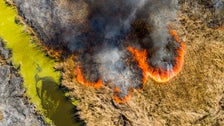
A NEW NORMAL
Scientists have known climate change is causing the Arctic to warm twice as quickly as the rest of the world, and the Siberian heat wave, which began in May, is typical of that trend.
“It becomes like an oven,” said Walt Meier, a senior research scientist at the National Snow and Ice Data Center at the University of Colorado who specializes in sea ice. “You are doing that on top of the longer-term warming trend, so you are getting the oven nicely baking a pie to scorching it.”
“What used to be extreme is becoming normal. Warmer temperatures are now relatively frequent,” Meier said.
And as temperatures warm, and polar snow and ice melt, more Arctic area is left darker and absorbs heat faster, which contributes to more warming. The Arctic sea ice has lost 70% of its summer volume since the 1970s, with the area also shrinking to the point that last year saw one of the lowest ice covers on record.
“WARNING CRY”
The peat fires make the need to cut man-made emissions all the more urgent, say scientists, who warn that wider changes in the Arctic could trigger bigger impacts on the global climate system.
“It’s a huge warning cry that’s going off, but it’s not the only systemic problem that’s happening in the Arctic related to climate change,” said Gail Whiteman, incoming professor of sustainability at Britain’s University of Exeter and founder of the Arctic Basecamp group of scientists advocating for rapid climate action.
Whiteman and other researchers are also worried about the rising heat thawing Arctic permafrost https://www.reuters.com/investigates/special-report/climate-change-arctic-methane faster than expected, which is liable to produce far larger quantities of carbon dioxide and methane than are being released by the fires.
Guido Grosse, head of the Permafrost Research Unit at the Alfred Wegener Institute Helmholtz Centre for Polar and Marine Research in Germany, said the fires were stripping away peat and vegetation that normally would form a protective blanket over the permafrost.
“If you take this away the heat from the summer penetrates directly into the ground and warms the permafrost, and it starts thawing,” he said. “You see this effect usually a few years after the fires.”
The warming temperatures also appear to be making the Arctic wildfire season longer, said Jessica McCarty, an assistant professor of geography at Miami University in Ohio. Typically, the Arctic fire season runs from July to August, plus or minus a couple of weeks. This year, fires were detected in May.
And “as the peat burns … its neighbor next door gets warmer, and their neighbors get warmer,” McCarty said. “We’re burning up these ancient pools of carbon.”
Credit: Source link